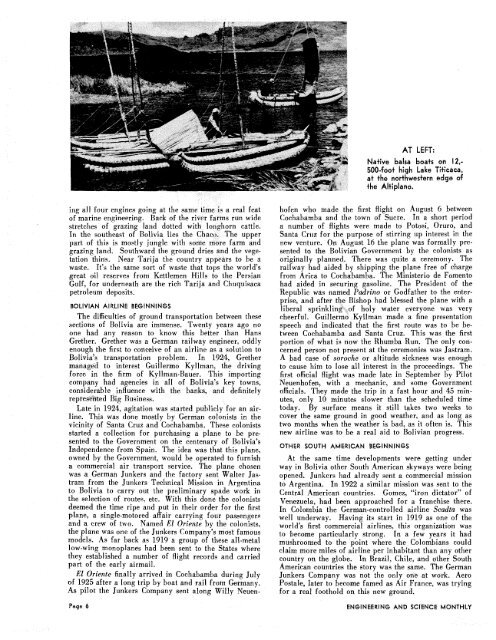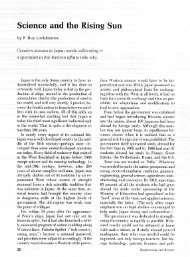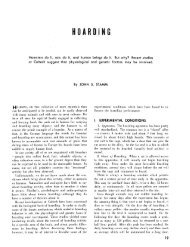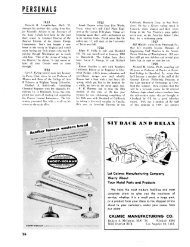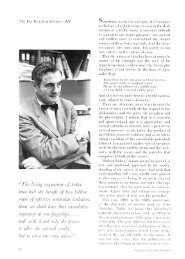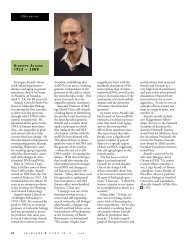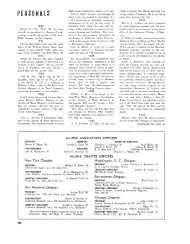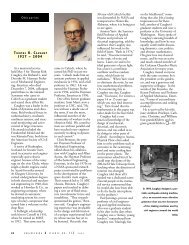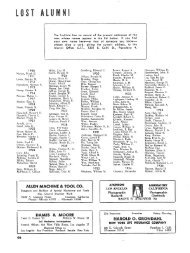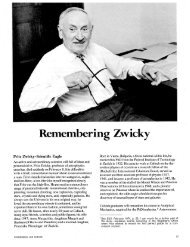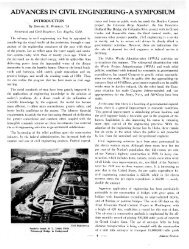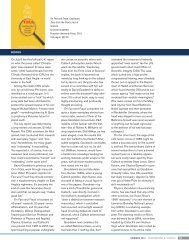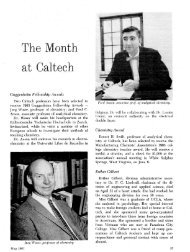Rhumba Run—Part 1 - Engineering & Science
Rhumba Run—Part 1 - Engineering & Science
Rhumba Run—Part 1 - Engineering & Science
You also want an ePaper? Increase the reach of your titles
YUMPU automatically turns print PDFs into web optimized ePapers that Google loves.
ing all four engines going at the same time is a real feat<br />
of marine engineering. Back of the river farms run wide<br />
stretches of grazing land dotted with longhorn cattle.<br />
In the southeast of Bolivia lies the Chaco. The upper<br />
part of this is mostly jungle with some more farm and<br />
gazing land. Southward the ground dries and the vege-<br />
tation thins. Near Tarija the country appears to be a<br />
waste. It's the same sort of waste that tops the world's<br />
great oil reserves from Kettlemen Hills to the Persian<br />
Gulf, for underneath are the rich Tarija and Chuquisaca<br />
petroleum deposits.<br />
BOLIVIAN AIRLINE BEGINNINGS<br />
The difficulties of ground transportation between these<br />
sections of Bolivia are immense. Twenty years ago no<br />
one had any reason to know this better than Hans<br />
Grether. Grether was a German railway engineer, oddly<br />
enough the first to conceive of an airline as a solution to<br />
Bolivia's transportation problem. In 1924, Grether<br />
managed to interest Guillermo Kyllman, the driving<br />
force in the firm of Kyllman-Bauer. This importing<br />
company had agencies in all of Bolivia's key towns,<br />
considerable influence with the banks, and definitely<br />
represented Big Business.<br />
Late in 1924, agitation was started publicly for an air-<br />
line. This was done mostly by German colonists in the<br />
vicinity of Santa Cruz and Cochabamba. These colonists<br />
started a collection for purchasing a plane to be pre-<br />
sented to the Government on the centenary of Bolivia's<br />
Independence from Spain. The idea was that this plane,<br />
owned by the Government, would be operated to furnish<br />
a commercial air transport service. The plane chosen<br />
was a German Junkers and the factory sent Walter Jas-<br />
tram from the Junkers Technical Mission in Argentina<br />
to Bolivia to carry out the preliminary spade work in<br />
the selection of routes, etc. With this done the colonists<br />
deemed the time ripe and put in their order for the first<br />
plane, a single-motored affair carrying four passengers<br />
and a crew of two. Named El Oriente by the colonists,<br />
the plane was one of the Junkers Company's most famous<br />
models. As far back as 1919 a group of these all-metal<br />
low-wing monoplanes had been sent to the States where<br />
they established a number of flight records and carried<br />
part of the early airmail.<br />
El Oriente finally arrived in Cochabamba during July<br />
of 1925 after a long trip by boat and rail from Germany.<br />
As pilot the Junkers Company sent along Willy Neuen-<br />
Page 6<br />
AT LEFT:<br />
Native balsa boats<br />
500-foot high Lake<br />
at the northwestern<br />
the Altiplano.<br />
on 12,-<br />
Titicaca,<br />
edge of<br />
hofen who made the first flight on August 6 between<br />
Cochabamba and the town of Sucre. In a short period<br />
a number of flights were made to Potosi, Oruro, and<br />
Santa Cruz for the purpose of stirring up interest in the<br />
new venture. On August 16 the plane was formally pre-<br />
sented to the Bolivian Government by the colonists as<br />
originally ~lanned. There was quite a ceremony. The<br />
railway had aided by shipping the plane free of charge<br />
from Arica to Cochabamba. The Ministerio de Fomento<br />
had aided in securing gasoline. The President of the<br />
Republic was named Padrino or Godfather to the enter-<br />
prise, and after the Bishop had blessed the lane with a<br />
liberal sprinkling of holy water everyone was very<br />
cheerful. Guillermo Kyllman made a fine presentation<br />
speech and indicated that the first route was to be be-<br />
tween Cochabamba and Santa Cruz. This was the first<br />
portion of what is now the <strong>Rhumba</strong> Run. The only con-<br />
cerned person not present at the ceremonies was Jastram.<br />
A bad case of soroche or altitude sickness was enough<br />
to cause him to lose all interest in the proceedings. The<br />
first official flight was made late in September by Pilot<br />
Neuenhofen, with a mechanic, and some Government<br />
officials. They made the trip in a fast hour and 45 min-<br />
utes, only 10 minutes slower than the scheduled time<br />
today. By surface means it still takes two weeks to<br />
cover the same ground in good weather, and as long as<br />
two months when the weather is bad, as it often is. This<br />
new airline was to be a real aid to Bolivian progress.<br />
OTHER SOUTH AMERICAN BEGINNINGS<br />
At the same time developments were getting under<br />
way in Bolivia other South American skyways were being<br />
opened. Junkers had already sent a commercial mission<br />
to Argentina. In 1922 a similar mission was sent to the<br />
Central American countries. Gomez, "iron dictator" of<br />
Venezuela, had been approached for a franchise there.<br />
In Colombia the German-controlled airline Scadta was<br />
well underway. Having its start in 1919 as one of the<br />
world's first commercial airlines, this organization was<br />
to become particularly strong. In a few years it had<br />
mushroomed to the point where the Colombians could<br />
claim more miles of airline per inhabitant than any other<br />
country on the globe. In Brazil, Chile, and other South<br />
American countries the story was the same. The German<br />
Junkers Company was not the only one at work. Aero<br />
Postale, later to become famed as Air France, was trying<br />
for a real foothold on this new ground.<br />
ENGINEERING AND SCIENCE MONTHLY


